|
|

Handbook on Viewing Buddhist Statues
A totally wonderful
book, by Ishii Ayako.
The top image
on this page was
scanned from this
book; Japanese language only; 192 pages; 80 or so
color photos.
Click here to
buy book at Amazon
Japanese Text Below
仏像の見方ハンドブック
石井 亜矢子 (著)
by Ishii Ayako
|
|
|
English
|
Japanese
|
Chinese
|
Sanskrit / Pali
|
Korean
|
Tibetan
|
|
Cosmic Buddha,
Sun Buddha,
Mandala Lord,
Central deity of
Esoteric Buddhism
|
Dainichi
Nyorai
大日如来
Dainichi
Tathagata
Daihenjō
大遍照
|
Dari, Dàrì Rúlái,
大日如来, Ta-jih,
Ta-jih Ju-lai
摩訶毘盧遮那
毘盧遮那佛,
最高顯廣眼藏,
遍照王如來,
光明遍照, 大日遍照,
遍一切處, 遍照尊
|
Mahavairocana,
Mahāvairocana,
Mahāditya,
Mahaditya,
Vairochana
Vairocana
|
Daeil,
Daeil Yeorae,
Taeil,
Taeil Yŏrae,
대일
|
Nang par nang dze,
Nampar Nangdze,
Nampar snang,
Nampar Namzay,
Rnam par snang
|
|
|
 
DAINICHI BUDDHA
Dainichi 大日 = Lit. "Great Sun”
Represents Center or Zenith.
Cosmic, Great, All-Encompassing Buddha.
Life Force Who Illuminates the Universe.
Supreme Deity of Japan’s Esoteric (Tantric) Sects.
Dainichi’s Messengers are the Wrathful Myō-ō.
Identified with Birushana Buddha and Shinto’s Sun Goddess
ORIGIN = INDIA
Central Deity among the Five Tathagata.
These five appear frequently in Japanese Mandala.
Important to Shingon & Tendai Sects of Esoteric Buddhism.
One of 13 Deities (Jūsanbutsu) invoked in Shingon memorial
services for the departed. Also serves as patron of people
born in Zodiac Years of the Sheep and the Monkey.

Dainich Mantra (Kongōkai Mandala) = On Basaradatoban

Dainich Mantra (Taizōkai Mandala) = Abiraunken
|
Sanskrit Seed Syllables for Dainichi Nyorai
|
|
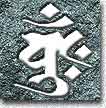
Bannku
|
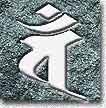
Ban
|
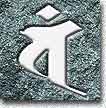
Ban
|
|
SANSKRIT IMAGES by permission from: TOBIFUDO
|
|

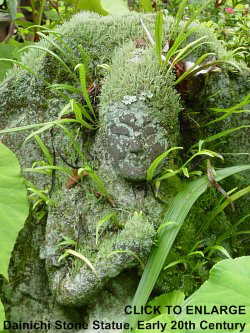  OVERVIEW. Dainichi Buddha (Sanskrit = Vairocana or Maha Vairocana) represents the center (zenith) among Japan's esoteric sects. Esoteric Buddhism (Jp. = Mikkyō 密教) is another term for Vajrayana (Tantric) Buddhism, one of the three main schools of Buddhism in Asia, most widely practiced today in Tibet. The other two forms are Theravada and Mahayana Buddhism. Mahayana is the mainstream in Japan, but the country's Shingon and Tendai sects are still strongholds of esoteric traditions, especially the Shingon sect. OVERVIEW. Dainichi Buddha (Sanskrit = Vairocana or Maha Vairocana) represents the center (zenith) among Japan's esoteric sects. Esoteric Buddhism (Jp. = Mikkyō 密教) is another term for Vajrayana (Tantric) Buddhism, one of the three main schools of Buddhism in Asia, most widely practiced today in Tibet. The other two forms are Theravada and Mahayana Buddhism. Mahayana is the mainstream in Japan, but the country's Shingon and Tendai sects are still strongholds of esoteric traditions, especially the Shingon sect.
As early as the Heian Period (794 - 1192 AD), devotees of Esoteric Buddhism in Japan worshipped Dainichi as the Central Buddha of the Universe, the Cosmic Buddha, the supreme deity of Esoteric Buddhism in Japan. But, prior to the intro of Esotoric Buddhism to Japan in the early 9th century, Dainichi was known as Birushana 昆盧遮那 (transliterated from Sanskrit “Vairocana”) or as Makabirushana 摩訶昆盧遮那 (transliterated from Sanskrit “Mahavairocana”). Indeed, a giant statue of Birushana was constructed in 752 AD in Nara, which is none other than the world-famous Nara Daibutsu (Big Buddha of Nara).
Dainichi generally supplants the Historical Buddha as the object of veneration among Japan's esoteric practitioners. Indeed, in Japan's Esoteric traditions, Dainichi is the most important of all the myriad Buddha. In fact, Dainichi is said to be everywhere and everything, like the air we breathe, with all other Buddha and divine beings considered as emanations of Dainichi. Dainichi is also one of the 13 Deities 十三仏 (Jūsanbutsu) of Japan’s Shingon Sect. In this role, Dainichi presides over the memorial service held on the 12th-year anniversary following one's death.
Dainichi’s Messengers. Images of Dainichi in Japan are also often surrounded by the Myō-ō, multi-armed and multi-headed protectors who represent Dainichi's wrath against evil and serve as Dainichi’s messengers.
Dainichi in Japanese Mandala (Mandara). Dainichi is the central figure in mandalas of the Shingon Sect of Japanese Esoteric Buddhism. In mandala scrolls and in paintings, Dainichi is typically surrounded by four other Buddha, each representing one of the directions of the compass. The five, with Dainichi Nyorai at the center, are known as the Five Tathagatas (Jp. = Gochi Nyorai). The most widely known mandala form in Japan is the Ryōkai Mandala (Two World Mandala, Ryokai, Ryoukai). Sometimes also written as the Ryōgai Mandala. It is composed of two separate mandala, which together represent the central devotional images of Esoteric Buddhism. The Taizōkai Mandala 胎蔵界 (Womb World Mandala, Sanskrit = Garbhadhatu) is based on the Dainichikyō Sutra (Jp), while the Kongōkai Mandala 金剛界 (Diamond World Mandala, Sanskrit = Vajradhatu) is based on the Kongōchōkyō Sutra (Jp). Even today, in Japanese Shingon temples, two large mandalas are typically mounted on both sides of the main image platform. The mandala on the east side is the Kongoukai Mandala, and the mandala on the west side is the Taizoukai Mandala. The Kongokai mandala represents the cosmic or transcendental Buddha (aka Dainichi Nyorai), while the Taizokai mandala represents the world of physical phenomenon.
Dainichi’s Mudra (Hand Gesture). Dainichi’s characteristic hand gesture in Japan (although not always) is the Mudra of Six Elements (Jp. = Chiken-in 智拳印) -- also called the Knowledge Fist Mudra. In this mudra, the index finger of the left hand is clasped by the five fingers of the right. This mudra symbolizes the unity of the five worldly elements -- earth, water, fire, air/wind, and space/void -- with spiritual consciousness. For a review of the most common mudra in Japan, please visit the Mudra page. For more on the Six Element Mudra, see below.
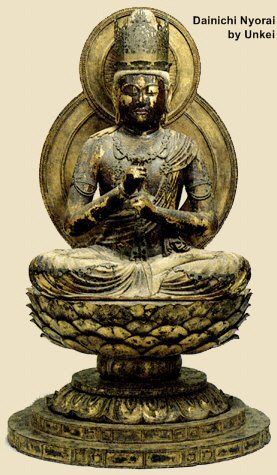
Dainichi Buddha 大日如来 by Unkei 運慶
Unkei’s earliest known work. Lacquer & gold leaf over wood.
Height = 101 cm. Dated +1176. Enjoji (Enjōji) Temple 円成寺 in Nara
Photo courtesy Handbook on Viewing Buddhist Statues.
By author Ishii Ayako. ISBN 4-262-15695-8. Japanese only.
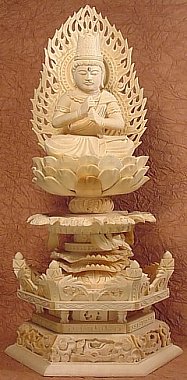 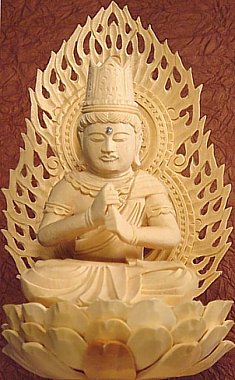
Dainichi Buddha (Nyorai) Sitting Atop Lotus
Statue Available for Online Purchase

DAINICHI - Various English Translations
- Cosmic Buddha, Buddha of Cosmic Life
- Great Illuminating One, Great Universally Illuminating One
- All-Encompassing Buddha, All-Encompassing Lord of the Cosmos
- Life Force That Illuminates the Universe
- Spreader of Light in All Directions
- Great Solar Buddha of Light and Truth
- Great Sun Buddha, Resplendent One
- Radiant Preacher, Luminous One
- Identified with Birushana Buddha (Skt. Vairocana). Indeed, Dainichi is the translation of Vairocana, while Birushana 昆盧遮那 is the transliteration of Vairocana. The direct translation of DAINICHI BUDDHA is “Great Sun Buddha.” The Sanskrit term Vairocana means "luminous one" or “embodiment of light” or "belonging to or coming from the sun." Vairocana represents the essential spiritual body of Buddha-truth (akin to light pervading everywhere).
- Especially important to Japan's Shingon Sect of Esoteric Buddhism
- Central deity among the Five Tathagata (Jp. = Godai Nyorai); these five appear frequently in Japanese mandalas, with Dainichi positioned in the center, surrounded by the other four, with each representing one of the cardinal directions.
- Dainichi's messengers are the Myo-o; also see Fudo page
- Guardian of People Born in the Zodiac Year of the Sheep and the Monkey.
Who is Your Patron Deity? Click Here to Find Out.

DAINICHI ARTWORK IN JAPAN
Appears as central figure in Japanese Mandala
Unlike most statues of the various Buddha (Nyorai) in Japan (which are simple and unadorned), images of Dainichi Buddha are typically depicted in the guise of a Bodhisattva -- with elaborately arranged hair topped with a crown, and wearing richly jeweled ornaments or garments. In addition, Dainichi in Japan appears in different forms based on the iconography of either the Womb World Mandala (Jp. = Taizoukai) or Diamond World Mandala (Jp. = Kongoukai), in which Dainichi is frequently portrayed (see Mandala Page). The mandala art form is especially important to Japan’s Shingon sect of Esoteric Buddhism, and Dainichi is their central object of worship.
Dainichi Buddha corresponds to the Historical Buddha's first turning of the Wheel of the Law in Deer Park in India, where the Historical Buddha gave his first sermon after attaining enlightenment. The Turning of the Wheel is a metaphor for teaching the way of enlightenment. Images of Dainichi are accordingly represented often with the preaching-hands gesture, called the Dharmacakra Mudra (Sanskrit; Jp. = Hokai Jo-in). See Mudra Page for more details. In both Japan and Korea, however, Dainichi's hands are more often depicted in the Mudra of Six Elements, which is also called the "Mudra of the Fist of Wisdom," the "Wisdom Mudra," or the “Knowledge Fist Mudra.” It is known as Chiken-in 智拳印 (ちけんいん) in Japan.
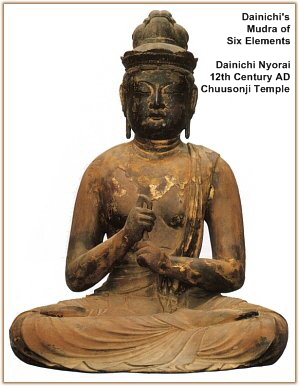   SIX ELEMENTS 六界 SIX ELEMENTS 六界
(Jp. = Rokukai ろくかい )
In Esoteric Buddhism, the five elements (Jp. = Goshiki 五行) are combined with one additional element, the MIND, for a total of six. Statues or paintings of Dainichi Buddha, the central deity of Esoteric Buddhism in Japan, often portray Dainichi with a characteristic hand gesture called the Mudra of Six Elements (Chiken-in 智拳印), in which the index finger of the left hand is clasped by the five fingers of the right. This mudra symbolizes the unity of the five worldly elements (earth, water, fire, air, and space) with a six element, spiritual consciousness. Others equate the left hand with the male organ and the right hand with the female organ, and maintain that it represents, by means of sexual symbolism, the central deity of the mandala from which all the other deities emanate. According to another interpretation, the left hand represents sentient beings and the right hand the Buddha, and thus symbolizes the two-way response of the Buddha and sentient beings.
In the Mandala artform, which is of special importance to Japan’s Esoteric sects (Shingon, Tendai), the five elements are considered inanimate (this equates to the Garbhadhatu or Womb World Mandala). Only by adding the sixth element -- mind, perception, or spiritual consciousness -- do the five become animate. This equates with the Vajradhatu or Diamond World Mandala. Phrased differently, there is “unity” only when the sixth element is added. Without the sixth element, ordinary eyes see only the differentiated forms or appearances.
- Earth
- Water
- Fire
- Air (or Wind)
- Space
- the MIND (spiritual consciousness or perception)

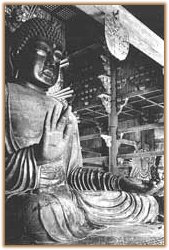  DAINICHI NYORAI DAINICHI NYORAI
An exception to the rule
Images of the Nyorai (Buddha, Tathagata) are rarely shown wearing jewellery or ornaments, but this is not always the case. Dainichi Nyorai, in fact, is one of the exceptions to the rule. Not only does the mudra of six elements help to identify Dai Nichi, but also images of Dai Nichi often show the deity wearing a crown and jewels.
One of the most famous examples of Dainichi can be found at Tōdai-ji in Nara (see photo at right). This is the world-famous Daibutsu of Nara, supposedly the largest bronze statue in the world. But it is actually Birushana Nyorai, not Dainichi Nyorai -- the two are manifestations of the same deity, and different sects give the deity different names. It is likely that Dainichi was “derived” from Birushana. Click here for more on Birushana and a history of the Big Buddha of Nara.

DAINICHI - The Cosmic Buddha and Mandalas
Below text courtesy of: Ancient Japan Gallery
Esoteric Buddhism was founded on the principle that the two aspects of Buddha, both the unchanging cosmic principle and the active, physical manifestation of Buddha in the natural world, were one and the same. The truth of the cosmic order, which is contained in the relationships between the Cosmic Buddha and all his manifestations, cannot be known verbally.
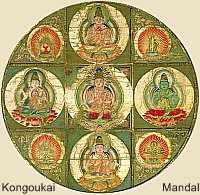  One method for understanding this truth was to comprehend it visually and symbolically; to this end, Japanese esoteric Buddhists imported the mandala (in Japanese, mandara), or circle, to express symbolically the order of the universe related to the cosmic Buddha. Since the Buddha occupied two separate realms, the mandala form that the esoteric priests imported was the Mandala of the Two Worlds, or Ryokai mandara (Ryo=two, kai=world, mandara=mandala). On the east side of the temple would be placed the Diamond World (Kongokai in Japanese, Vajradhatu in Sanskrit), which represented the world of the transcendental Buddha. It was called the Diamond World because it embodied a static, crystal clear, and adamantine truth of the universe. In the Diamond World, the Cosmic Buddha (Dainichi Nyorai in Japanese), sits in the center of assemblies of Buddhas arranged in a three by three square. One method for understanding this truth was to comprehend it visually and symbolically; to this end, Japanese esoteric Buddhists imported the mandala (in Japanese, mandara), or circle, to express symbolically the order of the universe related to the cosmic Buddha. Since the Buddha occupied two separate realms, the mandala form that the esoteric priests imported was the Mandala of the Two Worlds, or Ryokai mandara (Ryo=two, kai=world, mandara=mandala). On the east side of the temple would be placed the Diamond World (Kongokai in Japanese, Vajradhatu in Sanskrit), which represented the world of the transcendental Buddha. It was called the Diamond World because it embodied a static, crystal clear, and adamantine truth of the universe. In the Diamond World, the Cosmic Buddha (Dainichi Nyorai in Japanese), sits in the center of assemblies of Buddhas arranged in a three by three square.
|
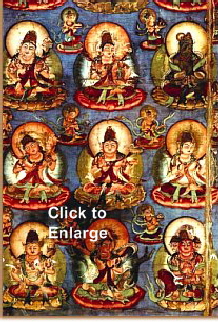
|
|
Detail from Taizokai (Womb World). The Ryokai Mandara is the oldest color mandala still in existence in Japan. It is believed to have been a copy made in China and brought to Japan in 859 AD by the Tendai priest, Enchin. Photo courtesy of Washington State University.
Photo Courtesy of:
Ancient Japan Gallery
|
|
 The other world, the Womb World (Taizokai in Japanese, Garbhadhatu in Sanskrit), was the world of physical phenomenon. In this mandala, the Dainichi Nyorai sits in the middle in relationship to all his physical manifestations ranged in several courts radiating outward from him. In the detail here, we see nine physical manifestations from the Lotus Holder's Court (which sits on the right side of the Court of Eight Petals, which is the court of the Cosmic Buddha). The physical manifestations of the Lotus Holder's Court represent the purity of all things. In the picture, you can see Buddha in several different aspects. To the bottom right, he is a three-headed, angry creature that represents the Buddha's ability to overcome evil (the three heads symbolize vigilance over evil). Most of the Buddhas, however, represent compassion or mercy. Not only are all the Buddhas surrounded by unique symbols, each one has a unique pairing of hand gestures, called mudras. The mudras are key in Buddhist practice; they recreate hand gestures from the life of Buddha. Not only did Buddha teach in words, he taught symbolically in hand gestures. Like all Buddhist art, a large part of the symbolic meaning is located in these hand gestures. For instance, the middle figure is making the semuiin gesture with his right hand (in Sanskrit, abhayamudra ). This means "fear not." Yes, an esoteric devotee could name each and every hand gesture in the picture you're looking at! The other world, the Womb World (Taizokai in Japanese, Garbhadhatu in Sanskrit), was the world of physical phenomenon. In this mandala, the Dainichi Nyorai sits in the middle in relationship to all his physical manifestations ranged in several courts radiating outward from him. In the detail here, we see nine physical manifestations from the Lotus Holder's Court (which sits on the right side of the Court of Eight Petals, which is the court of the Cosmic Buddha). The physical manifestations of the Lotus Holder's Court represent the purity of all things. In the picture, you can see Buddha in several different aspects. To the bottom right, he is a three-headed, angry creature that represents the Buddha's ability to overcome evil (the three heads symbolize vigilance over evil). Most of the Buddhas, however, represent compassion or mercy. Not only are all the Buddhas surrounded by unique symbols, each one has a unique pairing of hand gestures, called mudras. The mudras are key in Buddhist practice; they recreate hand gestures from the life of Buddha. Not only did Buddha teach in words, he taught symbolically in hand gestures. Like all Buddhist art, a large part of the symbolic meaning is located in these hand gestures. For instance, the middle figure is making the semuiin gesture with his right hand (in Sanskrit, abhayamudra ). This means "fear not." Yes, an esoteric devotee could name each and every hand gesture in the picture you're looking at!
An esoteric devotee would be asked to starre and meditate on each of these Buddhas in turn. He would meditate on their symbolic meaning as it is represented visually and he would meditate on that deity's relationship to the other deities as those relationships are represented visually. When he's fiinished with the Taizokai Mandara, he would move on to the Kongokai Mandara. Once he's meditated and, through visual and symblic understanding, come to comprehend all the Buddhas and their relationships across the two worlds, he will have unified himself with the Cosmic Buddha. Beginning priests would be asked to throw a blossom at each of the two mandalas; the deity that the blossom landed on would be adopted as that person's personal deity for the course of his study.
The Ryokai Mandara is the oldest color mandala still in existence in Japan. It is believed to have been a copy made in China and brought to Japan in 859 by the Tendai priest, Enchin.

DAINICHI: ONE OF THE FIVE GREAT BUDDHA OF WISDOM
courtesy buddha-gallery.net/pantheon.htm#jinas (no longer online)
The Buddha of the Zenith: Vairocana or Mahavairocana.
Japanese: Dainichi Nyorai, Rushana Butsu, Birushana Butsu
Chinese: Palushena.
He whose name means ”Spreader of Light in All Directions.” In Japan he is the “Great Solar Buddha of Light and Truth,” “The Resplendent One,” the “Radiant Preacher.” Dainichi corresponds to the Historical Buddha's first turning of the Wheel of the Law in Deer Park at Sarnath, his first sermon to his disciples after his enlightenment. The Turning of the Wheel is a metaphor for teaching the way of enlightenment. Dainichi is accordingly represented in the preaching gesture, the Dharmacakra mudra (Japanese: Hokai Jo-in). In Japan and Korea, however, Dainichi can also be seen in the ”mudra of the six elements,” or “mudra of the fist of wisdom.” This mudra is called “Chiken-in” in Japan. Please see Mudra page for details. Outside of Japan, Dainichi is sometimes shown holding a medicine jar in the left hand while the right hand forms the Abhaya or Varada mudra.
Dainichi Nyorai (Vairocana or Mahavairocana)
Represents the Tathagata (Buddha) family among the Five Budda Families. These five families are especially important to the Shingon Sect of Japanese Esoteric Buddhism, and they appear frequently in the Japanese Ryokai mandara. Dainichi Nyorai converts ignorance and bewilderment into the wisdom of primordial awareness, or the wisdom of universal lawfulness. Dainichi is known as the primordial or cosmic Buddha, and represents the center or zenith and the color white. Dainichi also represents body, earth, and eye consciousness. For a review of the Five Great Buddha and the families they represent, click here.
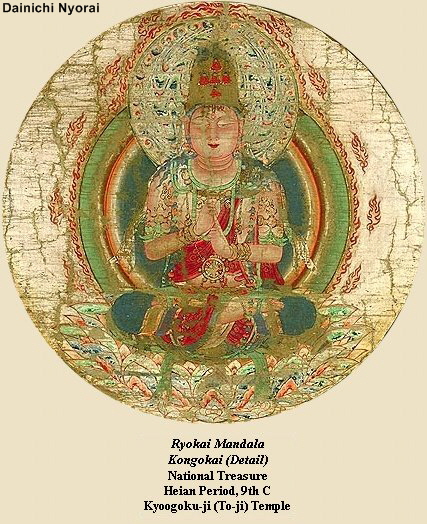

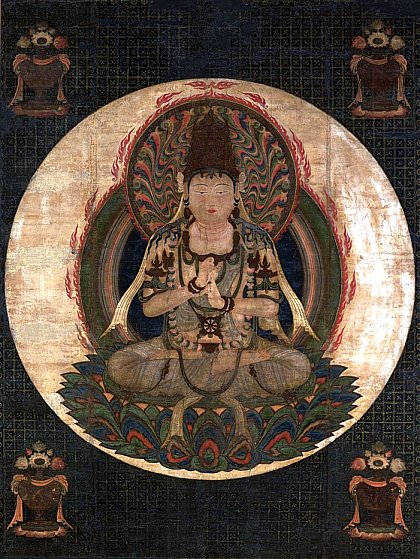
Ichiji Kinrin Butchou (Skt. = Ekaaksarausnisacakra)
AKA DAINICHI BUDDHA
Courtesy Tokyo National Museum
Formerly owned by the Hara Family.113.9 x 86.0
Kamakura Period, 13th century
The Mudra of Six Elements (Chiken-in 智拳印) is most commonly seen in images of Dainichi in the Diamond World Mandala (Kongoukai Mandara 金剛界曼荼羅), but is also found on other deities affiliated with Esoteric Buddhism, such as Ichijikinrin Butchou 一字金輪仏頂 (e.g., Chuusonji 中尊寺 in Hiraizumi 平泉, Iwate prefecture), Sonshou Butchou 尊勝仏頂 (e.g., central deity of the East Stupa on Mt. Kouya 高野), and Daishou Kongou 大勝金剛. < This last paragraph courtesy of JAANUS > For more details on the Butchou deities, click here.

 Showa Daibutsu (Aomori) Showa Daibutsu (Aomori)
Dainichi Buddha Daibutsu
Bronze, H = 21.35 Meters
Weight = 220 tons
Built in 1984 (Showa 59), the Showa Daibutsu is a giant effigy of Dainichi Nyorai, the central deity of worship among Japan’s Shingon sect of Esoteric Buddhism. Located at Seiryuu-ji Temple (Blue-Green Dragon Temple) in Aomori City, the statue is taller than the Nara Daibutsu and Kamakura Daibutsu. The temple itself is new, with construction launched in 1982.
SEIRYUUJI TEMPLE
AOMORI PREFECTURE
AOMORI CITY
TEL: 017-726-2312
FAX: 017-726-2124
Like many Shingon temples throughout Japan, Seiryuu-ji holds special light ceremonies during the Bon Festival (mid-August) to pray for the response of ancestors, dead children, and the transmigration of their departed souls. Indeed, there are many sites in Aomori Prefecture where grieving parents go to to pray and make offerings to pacify the soul of their lost child and to pacify their own soul as well. Details Here.
One of the most popular lighting ceremonies is the “Festival of Ten Thousand Lights” held during the Bon holidays. Details Here. The Seiryuu-ji Temple follows this tradition by holding Buddhist services for the dead and lighting ceremonies during the Bon period.

Says JAANUS: “Dainichi 大日 is the central and supreme deity of the pantheon of Esoteric Buddhism (Mikkyou 密教). In origin he has been linked to an ancient sun cult and to the Zoroastrian god of light, Ahura Mazda, and in Bradmanical literature the appelation Vairocana appears, for example, as the name of a legendary king and of the king of the Ashura 阿修羅. In Buddhism he assumes a central role in the KEGONKYOU 華厳経 (Skt. = Avatamsaka-sutra; see Rushanabutsu 盧舎那仏), and then with the development of Esoteric Buddhism he eventually took the place of Shaka 釈迦 as expositor of the Buddhist teachings, becoming the central figure in the Esoteric Buddhist pantheon as represented by the Womb World Mandala (Taizoukai Mandara 胎蔵界曼荼羅) and Daimond World Mandala (Kongoukai Mandara 金剛界曼荼羅). In Japan Dainichi also figures among the so-called Thirteen Buddha (Juusanbutsu 十三仏), presiding over the memorial service held on the 12th anniversary of a person's death. Dainichi differs icongraphically from other Buddhas in that he is represented in the form of Bodhisattva (Jp. = Bosatsu 菩薩), seated, wearing silk robes and accessories such as armlets and bracelets, and having long locks of hair. He also wears a "five-wisdom bejewelled crown" (Gochi Houkan 五智宝冠) on his head, symbolizing his identity with the Five Buddha (Gobutsu 五仏) and the five wisdoms attributed to them (Gochi Nyorai 五智如来), and he may be identified by his distinctive hand-gestures: in the Taizoukai Mandara he forms the "concentration seal of the Dharma-realm" (hokkai jouin 法界定印), with both hands lying on his lap, right on top of left, palms upward and thumbs touching, while in the Kongoukai mandara he forms the "seal of the knowledge fist" (chiken-in 智拳印), with the clenched right hand posed over the extended index finger of the otherwise clenched left hand. He is generally colored white, and his distinctive animal vehicle (Choujuuza 鳥獣座) is the lion; his standard seed-syllable (shuji 種子) in the Taizoukai Mandara is '栄' (Jp. = aku 惡) and in the Kongoukai Mandara 鑁 (Jp. = ban), and his symbol (sanmayagyou 三昧耶形) is a stura (tou 塔). Owing to the strength of the Shingon 真言 sect during the Heian period, there are many fine examples of images of Dainichi dating from this period, and in many cases he is found enshired in a stura (often the type known as a Tahoutou 多宝塔, either alone or as the central figure of a pentad consisting of the Five Buddhas; images according with his features in the Kongoukai Mandara are found to predomiate.” <end JAANUS quote>

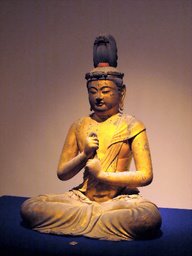  Unkei's wood sculpture sells Unkei's wood sculpture sells
for record $12.8 million in NY
NEW YORK, March 18, 2008 (AP)
A newly discovered wood sculpture attributed to the legendary sculptor Unkei sold Tuesday (March 18, 2008) for $12.8 million, or about 1.25 billion yen, in New York, the highest ever for any Japanese or Buddhist artwork auctioned in the world, said British auction house Christie. It was purchased by department store Mitsukoshi on behalf of a post-war Japanese Buddhist sect named Shinnyo-en <details on sect>. The sect manages a massive endowment of assets donated by followers.
A newly discovered wood sculpture attributed to the legendary sculptor Unkei sold Tuesday for $12.8 million, or about 1.25 billion yen, in New York, the highest ever for any Japanese or Buddhist artwork auctioned in the world, British auction house Christie's said.
Major Japanese department store operator Mitsukoshi Ltd. made a successful bid for the 12th century sculpture against a private American collector, according to the auction house. "History was made today with the phenomenal result of $14,377,000, which is a testament to the extreme importance and beauty of this supreme Buddha," said Katsura Yamaguchi, international director for Japanese and Korean Art. Yamaguchi was referring to the price with premium charged by the auction house.
Unkei was a favorite among warriors of the Kamakura period (1192-1333) known for his realistic and dynamic renditions of Buddhist figures.
The event has drawn strong interest from bidders as it was the first time that a work attributed to Unkei was put to auction outside Japan. Christie's said before the auction that the supreme Buddha "is the most valuable work ever offered in the category" of Japanese and Korean Art. The final bidding price shattered the presale estimate of $1.5 million to $2.5 million.
The Dainichi Nyorai figure, decorated in gold foil, is 66.1 centimeters tall and made of Japanese cypress. It sits on lotus position, with hair piled in a high topknot and wearing the crown and jewelry of royalty. According to Christie's, the statue has been owned by a private collector based in the northern Kanto region near Tokyo since 2000. The statue, originally housed in a temple in Ashikaga, Tochigi Prefecture, is believed to have been lost during the late 19th century when the Meiji government enforced a widespread anti-Buddhist movement in a bid to unite Japan under its native religion Shinto.
The Tokyo National Museum inspected the statue in 2003 with X-rays and found inside several dedicatory items, including a wood placard with pagoda-shaped finial and crystal ball supported by a bronze lotus stand that are characteristic to the school of Buddhist sculptors led by Unkei. Tsutomu Yamamoto, professor at Seisen University who conducted the examination, has said the statue dates back to the late 12th century and is likely attributed to Unkei based on its facial expressions, clothing design and the technique with which its hair is carved. But the statue has not been designated as a cultural asset by Japan's Cultural Affairs Agency, a status that would oblige the owner to inform the government of any plans for a sale. The agency so far designated 12 works made or believed to have been made by Unkei as national treasures or cultural assets.
"It was spectacular, because we're only here to bid on some small goods. And actually this was the first time for me to join the actual auction," said Frederick White, 56. "Buddha himself must have been surprised by this." © (Kyodo) News March 2008
For more details, see Gabi Greve’s Unkei page on this topic.
Also see Asahi Newspaper article (Japanese only).

Shinnyo-en 真如苑. Below text courtesy http://www.shinnyo-en.org
Shinjo Ito (1906-1989), the founder of Shinnyo-en, was ordained as a Shingon monk at Kyoto's Daigoji 醍醐寺 Monastery. After World War II, he established his own independent denomination and in 1952 he and his followers officially registered "Shinnyo-en" as a religious organization. When Shinjo died in 1989, leadership of the organization was passed along to his daughter Shinso Ito. Shinnyo-en literally means "Garden of Absolute Truth" or "Garden of the True Buddha" or "Field of the Tathagata." The organization provides mentoring and meditative training to lay practitioners and draws its inspiration from the Nirvana Sutra 涅槃經 and the important Buddhist philosophical concept of "thusness" -- written 眞如 or 真如 or Shinnyo. The concept refers to the eternal, impersonal, and unchangeable reality behind all phenomena. The organization does not (and need not) report its earnings, but most observers say it commands millions and millions in assets given freely by followers.

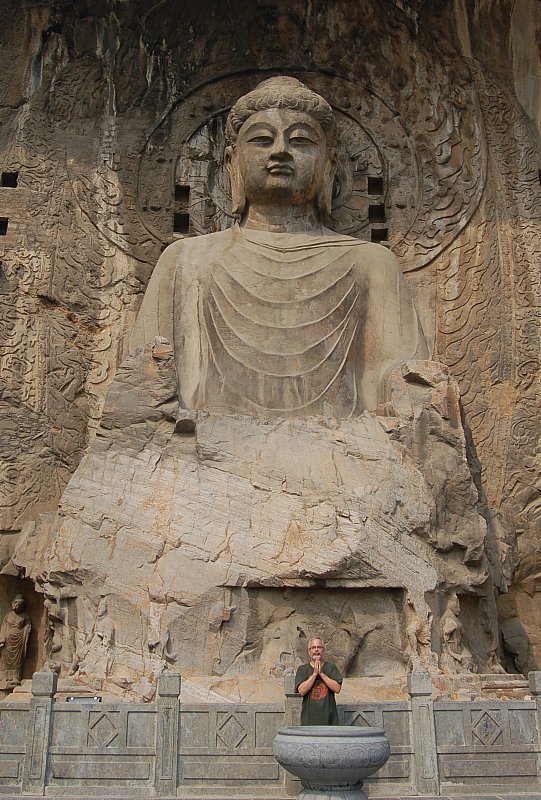
Dainichi Nyorai with site author Mark Schumacher (at bottom).
Fengxian Temple 奉先寺, China. Ancestor Worshipping Temple. Carving began in 672, completed circa 672-675 AD.
Central Image = Vairocana Buddha (Jp. = Dainichi Nyorai), Seated atop lotus; 17 meters in height; limestone.
Commissioned by Empress Wu Zetian, and reportedly made to resemble her facial features.
Longmen Caves Photo Tour Here

LEARN MORE

|
|